Related Research Articles

The Iran–Iraq War was an armed conflict between Iran and Iraq that lasted from September 1980 to August 1988. Active hostilities began with the Iraqi invasion of Iran and lasted for eight years, until the acceptance of United Nations Security Council Resolution 598 by both sides. Iraq's primary rationale for the attack against Iran cited the need to prevent Ruhollah Khomeini—who had spearheaded the Iranian Revolution in 1979—from exporting the new Iranian ideology to Iraq. There were also fears among the Iraqi leadership of Saddam Hussein that Iran, a theocratic state with a population predominantly composed of Shia Muslims, would exploit sectarian tensions in Iraq by rallying Iraq's Shia majority against the Baʽathist government, which was officially secular and dominated by Sunni Muslims. Iraq also wished to replace Iran as the power player in the Persian Gulf, which was not seen as an achievable objective prior to the Islamic Revolution because of Pahlavi Iran's economic and military superiority as well as its close relationships with the United States and Israel.

An oil spill is the release of a liquid petroleum hydrocarbon into the environment, especially the marine ecosystem, due to human activity, and is a form of pollution. The term is usually given to marine oil spills, where oil is released into the ocean or coastal waters, but spills may also occur on land. Oil spills may be due to releases of crude oil from tankers, offshore platforms, drilling rigs and wells, as well as spills of refined petroleum products and their by-products, heavier fuels used by large ships such as bunker fuel, or the spill of any oily refuse or waste oil.

The Gulf War was an armed conflict between Iraq and a 42-country coalition led by the United States. The coalition's efforts against Iraq were carried out in two key phases: Operation Desert Shield, which marked the military buildup from August 1990 to January 1991; and Operation Desert Storm, which began with the aerial bombing campaign against Iraq on 17 January 1991 and came to a close with the American-led Liberation of Kuwait on 28 February 1991.
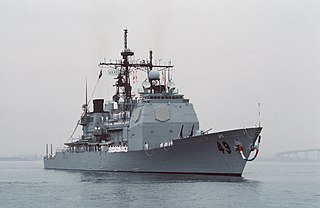
USS Vincennes (CG-49) was a Ticonderoga-class guided missile cruiser outfitted with the Aegis combat system that was in service with the United States Navy from July 1985 to June 2005. She was one of 27 ships of the Ticonderoga class constructed for the United States Navy and one of five equipped with the Mark 26 Guided Missile Launching System.
This is a list of aviation-related events from 1987.
This is a list of aviation-related events from 1988.
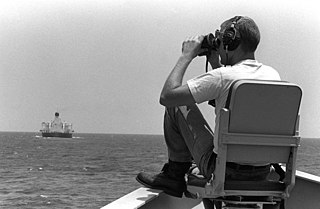
Operation Earnest Will was an American military protection of Kuwaiti-owned tankers from Iranian attacks in 1987 and 1988, three years into the Tanker War phase of the Iran–Iraq War. It was the largest naval convoy operation since World War II.

Operation Praying Mantis was the 18 April 1988 attack by the United States on Iranian naval targets in the Persian Gulf in retaliation for the mining of a U.S. warship four days earlier.

Ixtoc 1 was an exploratory oil well being drilled by the semi-submersible drilling rig Sedco 135 in the Bay of Campeche of the Gulf of Mexico, about 100 km (62 mi) northwest of Ciudad del Carmen, Campeche in waters 50 m (164 ft) deep. On 3 June 1979, the well suffered a blowout resulting in the largest oil spill in history at its time. To-date, it remains the second largest oil spill in history after the Deepwater Horizon oil spill.

The Iranian Navy traditionally located in the shallow waters of the Persian Gulf, has always been the smallest of the country's military forces. An Iranian navy in one form or another has existed since Achaemenid times in 500 BC. The Phoenician navy played an important role in the military efforts of the Persians in late antiquity in protecting and expanding trade routes along the Persian Gulf and Indian Ocean. With the Pahlavi dynasty in the 20th century that Iran began to consider building a strong navy to project its strength into the Persian Gulf and Indian Ocean. In more recent years, the country has engaged in domestic ship building industries in response to the western-backed Iraqi invasion of Iran, which left it without suppliers during an invasion.

A blowout is the uncontrolled release of crude oil and/or natural gas from an oil well or gas well after pressure control systems have failed. Modern wells have blowout preventers intended to prevent such an occurrence. An accidental spark during a blowout can lead to a catastrophic oil or gas fire.
The Battle of the Marshes was a part of the Iran–Iraq War.
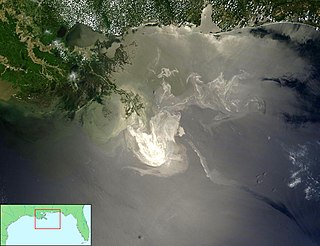
The Deepwater Horizon oil spill was an environmental disaster which began on April 20, 2010, off the coast of the United States in the Gulf of Mexico on the BP-operated Macondo Prospect, considered the largest marine oil spill in the history of the petroleum industry and estimated to be 8 to 31 percent larger in volume than the previous largest, the Ixtoc I oil spill, also in the Gulf of Mexico. Caused in the aftermath of a blowout and explosion on the Deepwater Horizon oil platform, the United States federal government estimated the total discharge at 4.9 MMbbl. After several failed efforts to contain the flow, the well was declared sealed on 19 September 2010. Reports in early 2012 indicated that the well site was still leaking. The Deepwater Horizon oil spill is regarded as one of the largest environmental disasters in world history.

The Deepwater Horizon drilling rig explosion was an April 20, 2010 explosion and subsequent fire on the Deepwater Horizon semi-submersible mobile offshore drilling unit, which was owned and operated by Transocean and drilling for BP in the Macondo Prospect oil field about 40 miles (64 km) southeast off the Louisiana coast. The explosion and subsequent fire resulted in the sinking of the Deepwater Horizon and the deaths of 11 workers; 17 others were injured. The same blowout that caused the explosion also caused an oil well fire and a massive offshore oil spill in the Gulf of Mexico, considered the largest accidental marine oil spill in the world, and the largest environmental disaster in United States history.
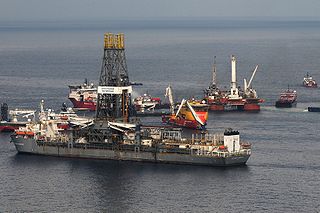
The following is a timeline of the Deepwater Horizon oil spill. It was a massive oil spill in the Gulf of Mexico, the largest offshore spill in U.S. history. It was a result of the well blowout that began with the Deepwater Horizon drilling rig explosion on April 20, 2010.
Following is a timeline of the Deepwater Horizon oil spill for July 2010.
Following is a Timeline of the Deepwater Horizon oil spill for May 2010.
MVABT Summer was an oil tanker which was built at the South Korean shipbuilding yard of Ulsan and launched in 1974. The vessel was 344 meters in length and almost 54 meters in breadth. While under a Liberian flag, fully laden with Iranian crude and en route to Rotterdam, she sank 700 nautical miles off the Angolan coast. An unexplained explosion occurred on May 28, 1991, and the ship and its cargo began to burn. Five of the crew of thirty-two were killed in the incident, four of whom were initially reported as missing. The following day, a slick 32 kilometres (20 mi) long and 7 kilometres (4.3 mi) wide began to form. The ship continued to burn for three days before sinking on June 1. The vessel's 260,000 tonne cargo of oil was lost, leaving a visible slick on the ocean surface of approximately eighty square miles. Attempts to locate the wreck following the incident proved unsuccessful.
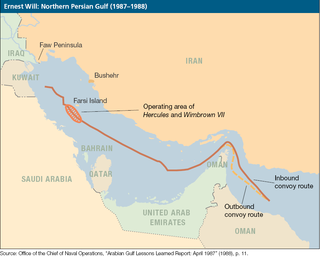
The Bridgeton incident was the mining of the supertanker SS Bridgeton by Iranian IRGC navy near Farsi Island in the Persian Gulf on July 24, 1987. The ship was sailing in the first convoy of Operation Earnest Will, the U.S. response to Kuwaiti requests to protect its tankers from attack amid the Iran–Iraq War.
References
- ↑ Roger Vielvoye (28 March 1983). "A messy reminder". Oil & Gas Journal. London: 57.
- 1 2 Emergency Response Division, Office of Response and Restoration, National Ocean Service (2010). "Nowruz Oil Field". IncidentNews. National Oceanic and Atmospheric Administration, US Department of Commerce. Archived from the original on 13 May 2010. Retrieved 12 May 2010.
{{cite web}}: CS1 maint: multiple names: authors list (link) - ↑ Ottaway, David B. (30 March 1983). "Gulf War Blocks Effort to Stop Large Oil Spill". The Washington Post . p. A25.
- ↑ "Nowruz – Cedre". wwz.cedre.fr. Retrieved 2 August 2016.
- ↑ "Oil Spills and Disasters". infoplease.com. Retrieved 2 May 2010.
29°32′00″N49°35′00″E / 29.5333°N 49.5833°E